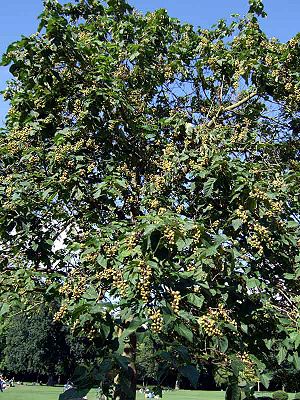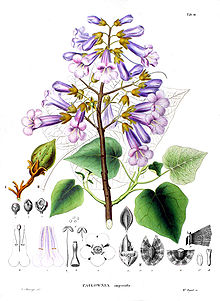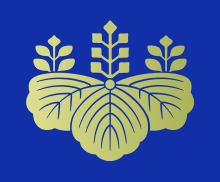Bluebell tree
| Bluebell tree | ||||||||||||
|---|---|---|---|---|---|---|---|---|---|---|---|---|

Bluebell tree ( Paulownia tomentosa ) with seed pods |
||||||||||||
| Systematics | ||||||||||||
|
||||||||||||
| Scientific name | ||||||||||||
| Paulownia tomentosa | ||||||||||||
| ( Thunb. ) Steud. |
The bluebell tree ( Paulownia tomentosa , syn .: Paulownia imperialis ), also called imperial tree or emperor paulownia , is a plant species from the genus of paulownia ( Paulownia ), which in turn forms the monotypical family of bluebell trees within the order of the mint-like (Lamiales).
Occurrence
The bluebell tree is native to central and western China . But it is cultivated far beyond that in Korea , Japan , North America and Europe as an ornamental tree and for wood use , especially in regions with a warm climate, where it is also found as an invasive species .
The tree makes no special demands on the soil; he prefers not too poor, moderately dry soils. A warm, sheltered location in a sunny location is important for the bluebell tree. In the youth it is sensitive to frost and needs winter protection by binding it with straw or frost protection mats. After cutting back the frozen shoots, strong new shoots take place. The bluebell tree is later hardy. The tree can develop from small cracks in walls and pavement.
description
Vegetative characteristics
The bluebell tree is a very fast growing, often richly branched, deciduous , deciduous tree with an average height of about 15 m, but it can get a lot higher; 20–30 m, occasionally even up to 50 m. It forms a straight trunk, usually about 30-60 cm thick; but this can reach up to two meters in diameter, thick branches and a wide, light crown . The bark in older trees is slightly cracked and gray-brown, in young trees it is smooth and the lenticels are clearly visible as bright spots. The young twigs have sticky glandular hairs.

Note the opposite constantly or verticillately arranged in small groups, an average of 15-30 cm long and 10-20 cm wide, cardiac to breiteiförmigen leaves (young plants and those at Stock rash they are up to 90 cm long). The long leaf stalks are hairy and up to 20 cm long. The soft leaves are dark green and sparsely hairy on the obverse, light green on the underside and short and velvety hairy. The leaves are pointed or pointed to blunt, the edges vary from full-margined on older plants and also roughly toothed on young ones and / or with three to five distant tips. The young leaves have sticky glandular hairs.
Generative characteristics
The hairy buds are orange-brownish. From April to May, before the leaves shoot, the hermaphrodite , stalked and five-fold flowers with a strong vanilla scent appear. They appear on terminal, upright branched, up to 40–50 cm high, stalked racemose and pyramidal inflorescences . The rust-brown, bell-shaped, pointed to rounded, unequal five-lobed, up to 1.5–2 cm long calyx is hairy outside and inside. The elongated, bell-shaped, light pink, violet to blue-violet and white flowers are 5–7 cm long. In the throat with yellow and whitish stripes, also partly more or less purple stripes and speckles. The outside hairy crown is five-lobed, two at the top, three at the bottom, the longitudinally ribbed corolla tube is up to about 5 cm long and 1.5 cm wide, the spreading, rounded lobes are about 1.5 cm long. The outspread flowers are about 4.5 cm in diameter.
The two-chamber, yellowish, fine-haired fruit node is upper constant and about 5 mm long, with a white, about 2 cm long stylus and capitate, white " tube scar ". The ovule is unitegic and anatropic. There are four, two each of unequal length, up to 2.5 cm long, enclosed stamens with white stamens and beige anthers.
The egg-shaped, four-chambered, back-fissured capsule fruit with a beak tip and four central longitudinal grooves is about 2.5-4.5 cm long and up to 2.5 cm wide. At first it is light green, short, rough-haired and sticky, then later dry and brown, it stays on the tree until the next blossom (over the winter). The woody pericarp is about a millimeter thick. One fruit contains 1000–2000 very light, brownish, small, flat, about 1.5 mm long, winged seeds, with wings the length is about 3-4 mm. The fan-shaped folded wings are whitish, transparent, membranous and multilayered. → Wind flyer ( meteorochory ). The thousand grain mass is only 0.15-0.2 g. The manhood is 4–5 to 8–10 years.
The large inflorescences, the nut-shaped capsule fruits and the velvety red-brown hairs of the branch tips make the bluebell tree unmistakable. Due to the similar leaf decoration, it is often confused with the trumpet tree or, when in bloom, with the jacaranda trees.
The bluebell tree has special excretory glands and glandular hairs ( trichomes ), which secrete mucilage that attracts insects, especially ants. These then serve as protection for the tree from herbivores .
The number of chromosomes is 2n = 40.
ingredients
The bluebell tree contains verbascoside . This is a glycosidic compound with glucose and rhamnose as the sugar component and with a 3,4-dihydroxyphenyl-1-hydroxyethanol and a caffeic acid residue on the glucose building block.
use

The wood is light, flame retardant , it insulates against low temperatures, is comparatively stable and visually appealing despite the high growth rates. It is used for furniture, surfboards or table tennis bats . In the latter, the core veneers are usually called Kiri in Japanese . In Japan, "Kiri-wood" traditional fireproof be made kimono cabinets geschreinert . Because of its tonewood properties, paulownia wood is also used for musical instruments , for example in traditional moon guitars and in the body of electric guitars.
As early as the 1980s, scientists were researching the agricultural usability because the trees (especially in the first year) grow rapidly.
history
The Würzburg naturalist, doctor and Japanologist Philipp Franz von Siebold brought the bluebell tree to Europe. Siebold was in Dutch services and named the tree after the Dutch Crown Princess, and later Queen Anna (Pavlovna), the daughter of the Russian Tsar Paul I was. The bluebell tree became the favorite tree of Emperor Franz Joseph . Many of the trees that are now in all the countries of the former Austrian Empire were planted there because of its arrangement. This explains the accumulation of bluebell trees in the centers of the former monarchy (e.g. Baden , Schönbrunn ).
The bluebell tree was part of a large number of Japanese coats of arms ( mon ), including a variant - Go-Shichi no Kiri ( Japanese. 五七 の genannt ) called - with three veined leaves and two 5-part and one 7-part flower next to the chrysanthemum was run by the Japanese imperial family . Today this forms the coat of arms of the Prime Minister and his cabinet .
Some bluebell tree varieties combine rapid growth and straight trunk growth and can provide coveted precious wood. The commercial production of valuable wood became the subject of investments . For plantings in Australia , however, the return fell well short of expectations due to plant diseases and bushfires . Many people lost their invested money.
literature
- Paulownia tomentosa in the Flora of China, Vol. 18.
Web links
- Thomas Meyer: Data sheet with identification key and photos at Flora-de: Flora von Deutschland (old name of the website: Flowers in Swabia ) .
- Photos from the Botanical Garden of the University of Vienna .
- Our kiri trees Bluebell trees (Japanese: "Kiri") are considered to be the fastest growing trees in the world - plantation cultivation in Germany.
- Bluebell Trees - Chinese bluebell tree extensive information and pictures about the bluebell tree, kiri tree and Nordmax21 cultivation.
- Brief portrait of the blue bell tree (Paulownia tomentosa) on waldwissen.net, accessed on August 19, 2017.
Individual evidence
- ↑ a b Pirro Icka, Robert Damo, Engjëllushe Icka: Paulownia Tomentosa, a Fast Growing Timber. In: Annals “Valahia” University of Targoviste - Agriculture. Volume 10, Issue 1, 2016, doi : 10.1515 / agr-2016-0003 .
- ↑ a b c Sawa Kobayashi u. a .: Anti-herbivore Structures of Paulownia tomentosa: Morphology, Distribution, Chemical Constituents and Changes During Shoot and Leaf Development. In: Ann. Bot. 101 (7): 2008, pp. 1035-1047, doi : 10.1093 / aob / mcn033 .
- ↑ a b c Editorial Committee: The European Garden Flora. Vol. VI: Dicotyledons , Cambridge Univ. Press, 2000, 2004, ISBN 0-521-42097-0 , p. 344.
- ↑ Paulownia tomentosa at EDDMapS, accessed on February 5, 2018.
- ^ Paulownia tomentosa on discoverlife.org, accessed August 15, 2017.
- ↑ FT Bonner a. a .: The Woody Plant Seed Manual. Agriculture Handbook 727, United States Dept. of Agriculture, 2008, ISBN 978-0-16-081131-9 , pp. 772 f, archive.org .
- ^ Robin J. Innes: Paulownia tomentosa. Fire Effects Information System, US Department of Agriculture, Forest Service, Rocky Mountain Research Station, Fire Sciences Laboratory (Producer), 2009, online at US Forest Service, accessed August 15, 2017.
- ^ Erich Oberdorfer : Plant-sociological excursion flora for Germany and neighboring areas . With the collaboration of Angelika Schwabe and Theo Müller. 8th, heavily revised and expanded edition. Eugen Ulmer, Stuttgart (Hohenheim) 2001, ISBN 3-8001-3131-5 , pp. 862 .
- ↑ Wood species ( Memento of February 13, 2009 in the Internet Archive ).
- ^ Final Technical Report of Paulownia Project ( Memento of October 27, 2011 in the Internet Archive ).
- ↑ History of the Kiri Tree . In: Kiribaum for the commercial production of valuable wood . Archived from the original on March 28, 2015.
- ^ Rudolf Lange : Japanese coat of arms . In: Eduard von Sachau (Hrsg.): Communications from the seminar for oriental languages at the Royal Friedrich-Wilhelms-Universität zu Berlin . Commissionsverlag v. Georg Reimer, Berlin 1903, p. 63-281 ( online transcript ).
- ↑ ABC News: 'Doomed' paulownia tree investment schemes leave hundreds without life savings. ABC, October 17, 2015, accessed January 3, 2018 .










